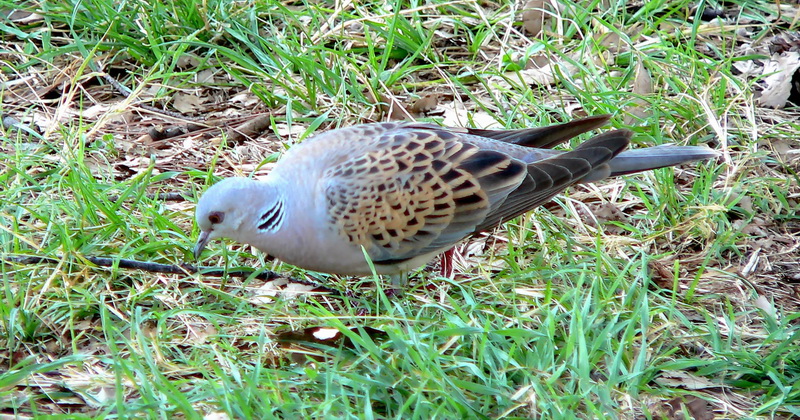|
| 질의: Ground dove | 결과: 75번째/126 | |
European Turtle Dove (Streptopelia turtur) - Wiki
| 제목: | European Turtle Dove (Streptopelia turtur) - Wiki
| |

| 해상도: 800x420
파일크기: 285493 Bytes
촬영일: 2006:08:26 17:47:19
사진기: DMC-FZ20 (Panasonic)
F number: f/2.8
Exposure: 10/500 sec
Focal Length: 720/10
등록시간: 2007:10:30 16:23:41
|
Turtle Dove
From Wikipedia, the free encyclopedia
[Photo] European Turtle-dove (Streptopelia turtur). Foto taken end of august in southern Istria. Date 26 August 2006. Author: Ulrich Prokop (http://commons.wikimedia.org/wiki/User:Scops) Copyright (C) 2006 Ulrich Prokop
Permission is granted to copy, distribute and/or modify this document under the terms of the GNU Free Documentation License, Version 1.2 or any later version published by the Free Software Foundation; with no Invariant Sections, no Front-Cover Texts, and no Back-Cover Texts. A copy of the license is included in the section entitled "GNU Free Documentation License". |
The Turtle Dove (Streptopelia turtur) is a member of the bird family Columbidae, which includes the doves and pigeons.
It is a migratory species with a western Palearctic range, including Turkey and north Africa, though it is rare in northern Scandinavia and Russia; it winters in southern Africa.
In the British Isles, France, and elsewhere in northwestern Europe it is in severe population decline. This is partly because changed farming practices mean that the weed seeds and shoots on which it feeds, especially Fumitory, are scarcer, and partly due to shooting of birds on migration in Mediterranean countries.
Smaller and slighter in build than other doves, the Turtle Dove may be recognised by its browner colour, and the black and white striped patch on the side of its neck, but it is its tail that catches the eye when it flies from the observer; it is wedge shaped, with a dark centre and white borders and tips. When viewed from below this pattern, owing to the white under tail coverts obscuring the dark bases, is a blackish chevron on a white ground. This is noticeable when the bird stoops to drink, raising its spread tail.
The mature bird has the head, neck, flanks, and rump blue grey, and the wings cinnamon, mottled with black. The breast is vinaceous, the abdomen and under tail coverts are white. The bill is black, the legs and eyerims are red. The black and white patch on the side of the neck is absent in the browner and duller juvenile bird, which also has the legs brown.
The Turtle Dove, one of the latest migrants, rarely appears in Northern Europe before the end of April, returning south again in September.
It is a bird of open rather than dense woodlands, and frequently feeds on the ground. It will occasionally nest in large gardens, but is usually extremely timid, probably due to the heavy hunting pressure it faces on migration. The flight is often described as arrowy, but is not remarkably swift.
The nuptial flight, high and circling, is rather like that of the Wood Pigeon, but the undulations are less decided; it is accompanied by the whipcrack of the downward flicked wings. The arrival in spring is heralded by its purring song, a rather deep, vibrating “turrr, turrr”, from which the bird's name is derived.
The nest is even more flimsy looking than that of the Wood Pigeon, being built of more slender twigs, usually at no great height, in a tree or old untrimmed hedge. The two white eggs are laid late in May or in June, often with a second clutch in July or August.
A few other doves in the same genus are also called turtle doves:
the Asian Oriental Turtle Dove S. orientalis and Spotted Turtle Dove S. chinensis.
the African Dusky Turtle Dove S. lugens and Laughing Dove S. senegalensis.
S. senegalensis and S. chinensis have been introduced into Australia.
A New World dove of similar appearance and behavior to that of the Turtle Dove is the Mourning Dove.
...
http://en.wikipedia.org/wiki/Turtle_Dove
| The text in this page is based on the copyrighted Wikipedia article shown in above URL. It is used under the GNU Free Documentation License. You may redistribute it, verbatim or modified, providing that you comply with the terms of the GFDL. |
|
댓글 |
|---|
| | 손님 |
|
Scientific Name: Streptopelia turtur (Linnaeus, 1758)
Common Names:
English – European Turtle-dove, European Turtle-Dove, European Turtle Dove, Turtle Dove
French – Tourterelle des bois
French: Tourterelle des bois German: Turteltaube Spanish: Tórtola europea
Other common names: Common Turtle-dove, Isabelline Turtle-dove (rufescens)
Taxonomy: Columba Turtur Linnaeus, 1758, India; error = England. |
^o^
동물그림창고 똑똑전화 누리집
^o^
|
|
|

